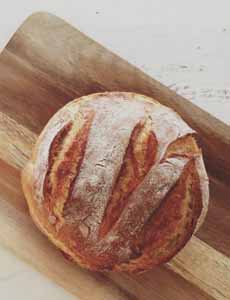
[1] A basket of baguettes, made by Hewn Bread in Chicago. Baguette is the longest French loaf.

[2] Note how these French loaves are shorter than baguettes. On the top shelf, slender ficelles appear to the left of batards, which are wider than baguettes. On the lower shelf, smaller bâtons in the front are wider than ficelles, but narrower than baguettes.

[3] Boule is a round, crusty loaf, similar to peasant bread (photo courtesy Artisan Bread In Five).

[4] French rolls (photo © La Rose Noire).
|
|
March 21st is National French Bread Day.
Every country makes a variety of different breads: harder and softer, rounder and flatter.
In France, the focus is on loaves (as opposed to flatbreads): different-shapes that have crusty exteriors and a chewy crumb.
In addition to the iconic baguette, other loaves—more wide or narrow, shorter or longer—include bâton, boule, ficelle and flûte.
It’s not easy for most of us to distinguish between French bread and Italian bread.
The situation is not helped by American supermarket breads, which often use generic labels like “French bread” and “Italian bread.”
Even with those labels, the actual loaf can be neither—i.e., a generic loaf.
Generic is not a pejorative title; it simply means that the features to not conform with the standards of a particular style of bread.
Consumers also can speak a generic language, seeking “French bread” when they mean “baguette,” or “Italian bread” when they mean a Sicilian-style loaf.
For National French Bread Day, we’re putting a toe in the water to provide some basic distinctions.
Thanks to Simmer & Zest for some of these distinctions.
Note that a discussion of every type of bread these two countries produce would take a vast amount of space. Our purpose is to provide a top line.
FRENCH BREAD VS. ITALIAN BREAD: THE DIFFERENCE
Geography
French bread styles tend to be available nationwide. While they may have originated in particular regions long ago, today’s bakeries offer most of them.
There are still regional specialties, such as fougasse from Provence, made with local ingredients such as olives or olive oil, sundried tomatoes, anchovies and/or herbs (similar to the Italian focaccia); and couronne, in the shape of a ring.
Italian loaves vary by region, from pane casareccio in Puglia and its cousin, pane genzano in Rome, both with crusty tops, to softer sesame-topped loaves from Sicily.
Ingredients
French bread is typically made from wheat flour, water, yeast and salt. By law in France, the long loaves and boules (round loaves) cannot have added oil or fat. Brioche, a soft loaf with a high egg and butter content, is considered a pastry.
Italian bread often contains a bit of milk or olive oil, and sometimes a bit of sugar.
Shape
French bread tends to be longer and narrower.
Italian bread loaves tend to be shorter and plumper.
Texture
French bread tends to be hard and crusty on the outside, with a light and soft crumb.
Italian bread can also have a hard crust, but the crumb tends to be denser.
Baking Method
French bread can be cooked in any oven.
Italian bread is traditionally baked in a flat stone oven. This can imbues the bread with a tiny amount of smoky flavor.
Now we’re going to the kitchen to butter a few slices!
> THE HISTORY OF BREAD
> THE DIFFERENT TYPES OF BREAD
|



